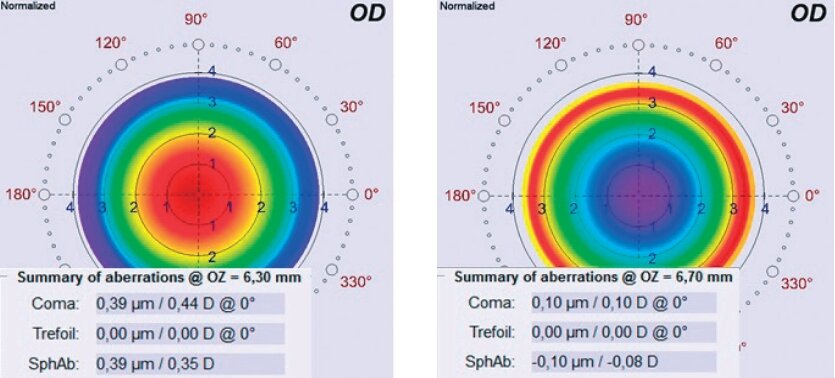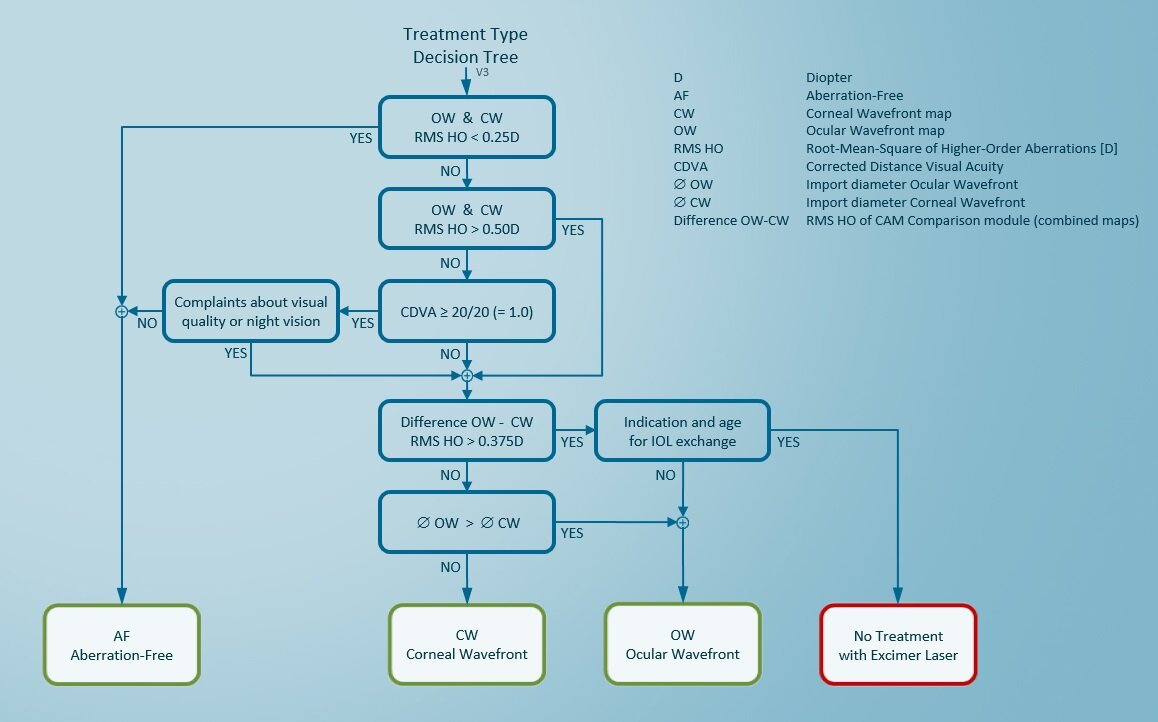Achieving accurate clinical outcomes and reducing the likelihood of a retreatment procedure are major goals of refractive surgery.
Cartesian-oval cornea
An ideal ablation profile should achieve these goals without the need for nomograms. A Cartesian-oval results from the condition of stigmatism and represents the free-of-aberrations surface for the infinity-point (far-point in a person). If the anterior corneal surface were a Cartesian-oval it would have no aberrations. However, the anterior cornea is typically different from this shape and possesses its own aberration pattern.
The concept of an Aberration-Free profile is based on a Cartesian-oval cornea with different dioptric power as a result of treatment planning. The focus shift due to tissue removal is theoretically balanced through the consideration of an aspheric anterior corneal surface, which preserves the optical focus location of the corrected anterior corneal surface, avoiding the induction of postoperative hyperopic shift.
In addition, the Aberration-Free concept involves different aspheric compensation as a function of the optical zone of treatment, further reducing the induction of spherical aberration and higher order astigmatism1. This compensation is however implemented in discrete steps of 0.5 mm of optical zone size.
Asymmetric offset
Centration of the ablation profile is critical and often a controversial topic of discussion. The determination of the true visual axis is still an open quest. The SCHWIND AMARIS uses a centration method for ablation profiles called asymmetric off-set, which considers Pupil Center and Corneal Vertex information simultaneously (fig.1)2. The ablation profiles cover the pupil aperture while respecting the Corneal Vertex as the optical axis of the ablation, where the refraction values are referred to the corneal vertex and the higher order aberrations are referred to the pupil center. This centration method avoids induction of coma aberration from defocus correction (but also trefoil aberration from astigmatism correction), saving tissue at the same time.
Dehydration model
Dehydration of the cornea during the treatment can affect the ablation efficiency and the laser tissue interaction. The cornea is a layered structure with different cellular pro-perties at different layers, rendering different refractive indices, water content and ablation properties to each layer. Further, (planar) flaps in (Femto-)LASIK result in small changes of the stromal corneal curvature. SCHWIND AMARIS counterbalances these effects through a multi-variate dehydration model3, and cornea and flap thickness compensation algorithm, respectively.
In addition, treatment modalities associated with different ablation depths within the cornea (stromal ablation methods compared to surface ablation methods), are implemented with appropriate ablation spots within the SCHWIND AMARIS.
Ease in treatment planning
The SCHWIND AMARIS features an automatic dynamic transition zone calculation. On the one hand, this feature may limit a surgeon’s possibilities for exploring different transition zone sizes, but on the other hand, it also offers an ease in treatment planning,
always ensuring that identical treatments receive the same transition zone. Patient’s age not only affects their ability to accommodate, but also the water content in the cornea4. This and other factors are compensated in the ablation profiles through a correlation based algorithm calculating a compensation factor for different ages.
Powerful Tool
With a myriad of customization possibilities, each with their own benefits, limitations and implications, it may become immensely complicated to decide the optimum individualized treatment method for a patient. The “Decision Tree” by SCHWIND is a powerful tool to select the treatment mode best suited to the needs and condition of the patient, in a step-by-step fashion (fig. 2).
These features succinctly highlight the state-of-the-art technological ad-vancements and useful tools offered by the modern ablation profiles. Even with their associated physical limitations, these integrated features bring the Aberration-Free concept very close to realizing its goal of delivering what it promises, a truly “Aberration-Free” treatment.
1 Arba Mosquera S, de Ortueta D. Analysis of optimized profiles for ‘aberration-free’ refractive surgery. Ophthalmic Physiol Opt;. 2009; 29: 535-548
2 Arba Mosquera S, Ewering T. New asym-metric centration strategy combining pupil and corneal vertex information for ablation procedures in refractive surgery: theoretical background. J Refract Surg. 2012 Aug;28(8):567-75
3 de Ortueta D, von Rüden D, Magnago T, Arba Mosquera S. Influence of stromal refractive index and hydration on corneal laser refractive surgery. J Cataract Re-fract Surg. 2014 Jun;40(6):897-904
4 Luger MH, Ewering T, Arba-Mosquera S. Influence of patient age on high myopic correction in corneal laser refractive surgery. J Cataract Refract Surg. 2013 Feb;39(2):204-10


